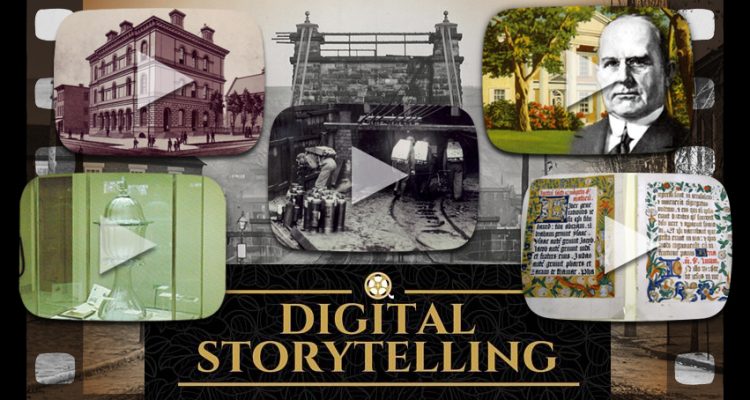Bringing Archives to Life 
A Weelunk partnership with Archiving Wheeling.
For more great Wheeling stories visit www.archivingwheeling.org.
Most history lovers are familiar with Ken Burns’ epic documentaries, including The Dustbowl and Baseball. His abilities to make still photos and two-dimensional objects come alive are world-renowned. Now, even Luddites can achieve similar, engaging effects with archival materials using a much shorter medium called digital storytelling.
Started as a grassroots movement to help people who might otherwise go unheard tell and share their stories, digital storytelling has become a vehicle for change around the world. To create a digital story, the storyteller needs a computer, iPad, or Smartphone, free digital storytelling software, a microphone, and digital images. The aim is to write a script that can be told in about three to five minutes. Once created, the digital story can be shared on the Internet, especially through social media, which broadens the audience reach exponentially.
Through a partnership with the Heinz History Center in Pittsburgh, Pa., my Honors students at California University of Pennsylvania have spent the last three years creating digital stories with archival materials from historical societies throughout western Pennsylvania. This year, we are working in my home state of West Virginia.
My students arrived in Wheeling on Oct. 15 after a one-hour trip along I-70 from California, Pa. We met at Wheeler House, a large cottage in Oglebay Park. That evening, we served dinner to our guests, sponsored by Alpha Delta Kappa, Iota chapter, an International Teaching Sorority. Following dinner, Dr. David Javersak, a retired history professor from nearby West Liberty University, enlightened my students with a brief history of Wheeling. By the end of his presentation, it was clear that my students and our guests were enthralled with the region from its early days as a frontier outpost to its present manifestation as a thriving arts community.

The next morning my students went in small groups to five different historical archives: Independence Hall, the Ohio County Public Library, Oglebay Mansion Museum, Oglebay Glass Museum, and West Liberty University’s Rare Books Room. In addition to Professor Javersak’s lecture, students prepared for their visits by researching and writing about Wheeling history in general and their sites in particular. In more than 19 years of teaching college English, I cannot remember the last time my students were so excited about learning. In fact, Jacob Rice and Austen Owens learned so much at Independence Hall that they gave Robert Stakeley, the Education Outreach Coordinator at the Heinz History Center, and me a tour of the Hall with full and accurate narration!
In the middle of their long work day, the students were treated to some Wheeling favorites: Coleman’s fish and DiCarlo’s pizza. Felix Rivera, a native of Brooklyn, bragged that DiCarlo’s was as good as any New York pizza he’d eaten—a fact that few natives would dispute.
The excitement persisted once we returned to campus. Rebecca Wokley, Vanessa Martik, and Maria Martik, who worked with the Oglebay Glass Museum, proudly exclaimed, “We got to touch a piece of glass that only 12 other people had ever touched before!” Clearly, their adventures in Wheeling had left a marked impact on them.

In the weeks that followed, the students worked to create two digital stories: an introduction to the historical society, including an overview of their collections, and a feature story examining one person, place, or event in great detail. In the end, they decided to tell the following stories:
- West Liberty University Rare Books Room—the history of the printed word
- Ohio County Public Library Archives—the Benwood Mine Disaster
- Oglebay Mansion Museum—Earl W. Oglebay and agricultural advancement
- Oglebay Glass Museum—Sweeney Glass
- Independence Hall—the formation of the state and the Civil War
The students will premiere their work at the Ohio County Public Library on Dec. 5 at Noon. The public is welcome and encouraged to attend this free event. Light refreshments will be provided. After the event, the digital stories will be available on the Heinz History Videos HCAP Facebook page and on Weelunk.com and ArchivingWheeling.org.
My students and I will be back in the Mountain State again next semester. We will be focusing on the history of Marshall and Wetzel Counties.
To get a sense of the kinds of projects the students will be showing at the premiere, please watch the following digital story created by Rachael Fawley and Corinne Dowlin for my Honors 150 course in fall 2013. To date, this video has been viewed nearly 5,000 times and has appeared on C-SPAN. It explores the deadly Donora, Pa., Smog of 1948.


